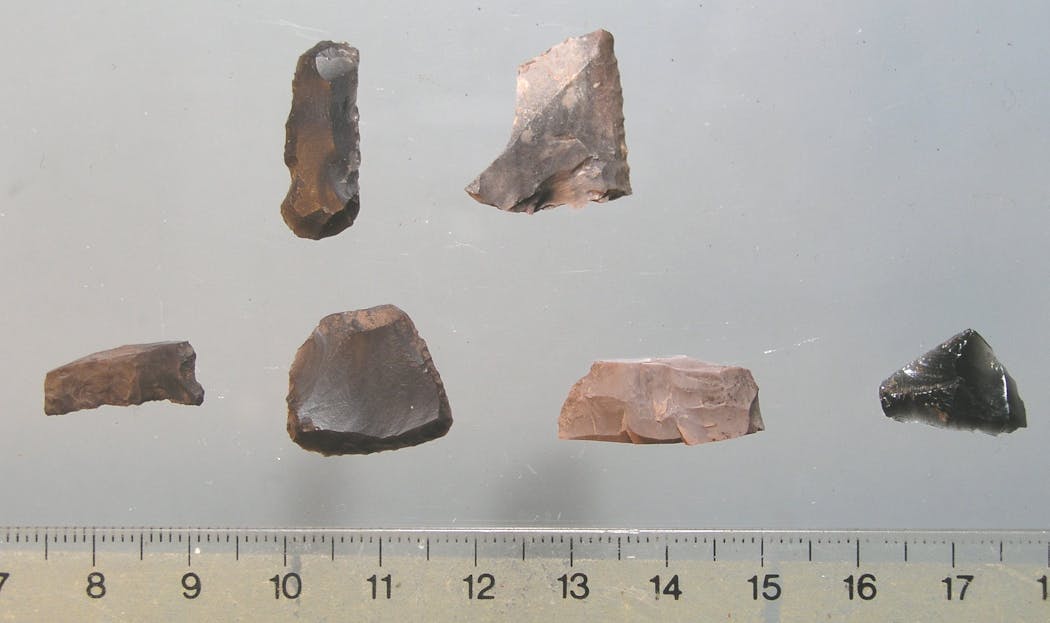DULUTH — The day archaeologists discovered ancient pottery pieces in a remote area of the Superior National Forest in 2003 wasn't especially significant.
The pieces emerged while a team from the U.S. Forest Service was mitigating erosion in the border lakes region of the Boundary Waters Canoe Area Wilderness.
"I remember thinking it was very cool, this beautiful pottery," said conservation archaeologist Lee Johnson.
But pieces are handled carefully in the field to preserve them, and it wasn't clear that day that some still bore the traces of a long ago meal, the key to pinpointing when an intact bowl was used and which ancient people used it to hold food.
Then the sherds sat for 19 years in a curation room at the Forest Service's Duluth office, until the agency last summer found the funding to perform radiocarbon dating testing on those pieces and some others in its collection.
In December, the results came back: The sherds are from 1,750 to 1,600 years ago — or 272 to 422 A.D.
"We talk about the Superior National Forest and border routes, people living here 10,000 years ago," Johnson said. "Having that date to back up that story is really important for us. Archaeology is like a book with pages ripped out. This adds a really cool page in that book, and it is clear."
The decorative pattern of the vessel points to a group of ancestral Native Americans called the Laurel people, known to live in a wide-ranging area that extended from Lake Superior to Manitoba and Ontario between 2,100 and 1,200 years ago. They were the earliest in the area to adopt mound building and trade networks, said David Mather, an archaeologist with the Minnesota State Historic Preservation Office.
"Out of all that area, the BWCA has perhaps the best representation and preservation of all that history," he said in a news release. "It is powerful to connect an artifact — in this case, a meal that was cooked — to a specific point in time."
The Laurel people lived a seasonal life, similar to the Ojibwe, said Linda LeGarde Grover, professor emeritus of American Indian studies at the University of Minnesota Duluth and a member of the Bois Forte Band of Chippewa.
They moved through the seasons for available sustenance like fish and wild rice, revolving life around harvesting, gathering, planting and preserving, she said.
The finding builds on other discoveries from that area, including a 2008 obsidian flake sourced to Bear Gulch, Idaho, indicating trade extended more than a thousand miles. Leftover chunks of stone tools from shaping arrowheads have been frequent archaeology finds over the years. Researchers from a Thunder Bay university found corn and wild rice remains on ceramic pieces and in soil samples at the same border lakes site in 2010.
The Forest Service works with the Bois Forte Band to ensure archaeological and historic sites are managed correctly, and that tribes have a voice in the process.
Archaeological finds have shown how civilized the area's Native American ancestors were, said Shane Drift, a member of the Bois Forte Tribal Council. The findings help educate the public on "how amazing our people were," Drift said. "They lived with the land, lived with the seasons. Knew when to pick medicines. ... It is important to know."
The Forest Service won't reveal the locations of most archaeological sites because of their sacredness to Native people and need to be preserved as part of the forest's federal designation. If forest users do make a discovery, they're asked to photograph it and note a GPS point, but leave it in place and notify forest officials. But not all archaeological BWCA sites are a secret. The ancient rock art, or pictographs, along the Boundary Waters' Crooked Lake and Lac La Croix are visible to paddlers and are popular attractions.
Those pictographs and other primitive forest finds tell a story, Johnson said, of how people in the harsh northern reaches of Minnesota lived, and their "amazing resilience."

Former diversity worker sues University of Minnesota after firing over swastika photo

As longtime Hutchinson, Litchfield papers close, 2 newspapers launch to take their place

In Grand Rapids, Itasca Pride is planning its first event, but there is already pushback
Mother charged with fentanyl overdose death of her 8-month-old boy in Roseville hotel room


